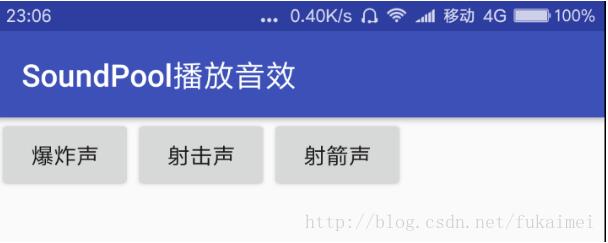Android使用SoundPool实现播放音效
如果在程序应用中(比如:游戏的音效等)需要播放密集、短促的音效,这时就使用SoundPool来播放音效,SoundPool使用音效池的概念来管理多个短促的音效,例如它可以开始就10个音效,以后在程序中按音效的ID进行播放。
SoundPool主要用于播放一些较短的声音片段,与MediaPlayer相比,SoundPool的优势在 于CPU资源占用量低和反应延迟小。另外,SoundPool还支持自行设置声音的品质、音量、播放比率等参数。
一般使用SoundPool播放声音的步骤如下:
Step1:调用SoundPool.Builder的构造器创建SoundPool.Builder对象,并可通过该Builder对象为SoundPool设置属性;
Step2:调用SoundPool的构造器创建SoundPool对象;
Step3:调用SoundPool对象的load()方法从指定资源、文件中加载声音。最好使用HashMap< Integer, Integer>来管理所加载的声音;
Step4:调用SoundPool的play()方法播放声音。
下面的Demo程序示范了如何使用SoundPool来播放音效,该程序提供三个按钮,分别用于播放不同的声音。
layout/activity_main.xml界面代码如下:
<?xml version="1.0" encoding="utf-8"?> <LinearLayout xmlns:android="http://schemas.android.com/apk/res/android" android:layout_width="match_parent" android:layout_height="match_parent" android:orientation="horizontal"> <Button android:id="@+id/bomb" android:layout_width="wrap_content" android:layout_height="wrap_content" android:text="爆炸声" /> <Button android:id="@+id/shot" android:layout_width="wrap_content" android:layout_height="wrap_content" android:text="射击声" /> <Button android:id="@+id/arrow" android:layout_width="wrap_content" android:layout_height="wrap_content" android:text="射箭声" /> </LinearLayout>
MainActivity.java逻辑代码如下:
package com.fukaimei.soundpooltest;
import android.media.AudioAttributes;
import android.media.SoundPool;
import android.os.Build;
import android.support.annotation.RequiresApi;
import android.support.v7.app.AppCompatActivity;
import android.os.Bundle;
import android.view.View;
import android.widget.Button;
import java.util.HashMap;
public class MainActivity extends AppCompatActivity implements View.OnClickListener {
Button bomb, shot, arrow;
// 定义一个SoundPool
SoundPool soundPool;
HashMap<Integer, Integer> soundMap = new HashMap<>();
@RequiresApi(api = Build.VERSION_CODES.LOLLIPOP)
@Override
protected void onCreate(Bundle savedInstanceState) {
super.onCreate(savedInstanceState);
setContentView(R.layout.activity_main);
bomb = (Button) findViewById(R.id.bomb);
shot = (Button) findViewById(R.id.shot);
arrow = (Button) findViewById(R.id.arrow);
AudioAttributes attr = new AudioAttributes.Builder().setUsage(AudioAttributes.USAGE_GAME) // 设置音效使用场景
.setContentType(AudioAttributes.CONTENT_TYPE_MUSIC).build(); // 设置音效的类型
soundPool = new SoundPool.Builder().setAudioAttributes(attr) // 设置音效池的属性
.setMaxStreams(10) // 设置最多可容纳10个音频流
.build(); // ①
// load方法加载指定音频文件,并返回所加载的音效ID
// 此处使用HashMap来管理这些音频流
soundMap.put(1, soundPool.load(this, R.raw.bomb, 1)); // ②
soundMap.put(2, soundPool.load(this, R.raw.shot, 1)); // ②
soundMap.put(3, soundPool.load(this, R.raw.arrow, 1)); // ②
bomb.setOnClickListener(this);
shot.setOnClickListener(this);
arrow.setOnClickListener(this);
}
// 重写OnClickListener监听器接口的方法
@Override
public void onClick(View v) {
// 判断哪个按钮被单击
if (v.getId() == R.id.bomb) {
soundPool.play(soundMap.get(1), 1, 1, 0, 0, 1); // ③
} else if (v.getId() == R.id.shot) {
soundPool.play(soundMap.get(2), 1, 1, 0, 0, 1); // ③
} else if (v.getId() == R.id.arrow) {
soundPool.play(soundMap.get(3), 1, 1, 0, 0, 1); // ③
}
}
}
上面Demo程序代码中标①的代码用于创建SoundPool对象;标②的代码用于使用SoundPool加载多个不同的声音;标③的代码则用于根据声音ID来播放指定的声音。这就是使用SoundPool播放声音的标准过程。
实际使用SoundPool播放声音时有如下几点需要注意:SoundPool虽然可以一次性加载多个声音,但由于内存限制,因此应该避免使用SoundPool来播放歌曲,只有那些短促、密集的声音才考虑使用SoundPool进行播放。
Demo程序运行效果界面截图如下:

以上就是本文的全部内容,希望对大家的学习有所帮助
您可能感兴趣的文章:
- Android游戏开发中使用SoundPool来实现音效的播放
- android使用SoundPool 播放短音效
- Android移动开发-使用SoundPool播放音效的实现
- Android之使用SoundPool播放一小段音频,实现猜歌的功能
- Android使用SoundPool播放音效
- Android使用SoundPool播放音效实例
- android使用SoundPool 播放短音效
- 初学Android,多媒体之使用SoundPool播放音效(七十六)
- android使用SoundPool播放音效的方法
- Android 使用SoundPool播放音效
- 【Android开发学习03】短时间的音效播放实现SoundPool
- Android使用SoundPool实现播放音频
- android使用SoundPool 播放短音效
- Android之MediaPlayer播放一般音频与SoundPool播放短促的音效
- 【Android】使用Gallery组件实现图片播放预览
- 【Android】Android开发实现进度条效果,SeekBar的简单使用。音量,音乐播放进度,视频播放进度等
- 【手机变身无线音箱-WIFI流媒体传输】--音乐在PC和手机间双向播放-详解Android DLNA使用-使用DLNA实现不同设备间媒体共享
- Android开发之使用VideoView实现视频的横屏播放、去除边框
- [置顶] 【Android】Android开发实现进度条效果,SeekBar的简单使用。音量,音乐播放进度,视频播放进度等
- Android游戏开发之音效SoundPool的使用
